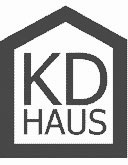Planning your new house is only the start of the process. Your vision should be affordable and appropriate for the site. We will help you through every step of the way, from face to face discussions with our architects to careful preparation of budget plans.
If you want to discuss your project with our architect team, then just arrange an appointment with us in our London Bridge offices.
Do you want to meet the German team who will be assembling your house? No problem. KD Haus welcomes you to its headquarters in Ratingen near Dusseldorf. There you can see several completed show houses, walk around and open doors and windows, see how everything works. There is no substitute for a 'hands on' demonstration.

Find a Site
A building plot for sale can take up to 50 percent of the total budget of the self build. Beyond planning your home, locating and buying a building plot for sale is the next step in realising a self build home - and arguably the hardest and most important.
Building plots for sale with planning permission can be expensive, however plots for sale are available without planning permission and can offer a big saving on cost, but there are no guarantees that permission will be granted. It is often useful to seek advice from a Solicitor or Estate Agent about the status of the land and the possibility of obtaining Planning Permission, or contact the Local Authority directly.
Once you have found your site, there are many documents that need to be provided, such as a proper computer drawn site survey and a soil report. We can help you with our checklists of what will be required.
Mortgages, Finance & VAT
Proper financing will be crucial to the success of the project. KD will work with the client to agree a monthly cashflow proposal, before work starts. KD Haus provide fixed priced contracts for the work, to give you complete peace of mind. KD Haus can also give customers advice on sources of finance and provide the documentation that is required for a grant funding application where appropriate. Mortgages tailored to the specific requirements of Self Builders are available from a variety of lenders. A Self Build mortgage is a product specifically tailored to your construction programme.
One benefit for the self build approach is that there is currently no VAT levied on new houses. Any VAT paid for materials during construction can be reclaimed at the end of the project. If you pay a builder for work done, he may reclaim the VAT paid on materials supplied by him, and his invoices to you will be zero-rated.
Another of the benefits of self building is in stamp duty as you only pay, based on the purchase price of the plot and not on the value of the completed house.
Other tax advantages for the self builder include exemption from capital gains tax when the self build home is sold. Self build homes account for around 10 percent – over 20,000 of all residential properties built each year. The most common self-built house is a detached home. But, at the end of the build, if you do your sums right and have the right house in the right place, then the property will be worth more than the sum you have invested.


Planning Permission
Your new house will need Planning Permission. Your building plot may already have outline planning permission, in which case your new house will need detailed plans submitted for full permission. It is always advisable to contact the Local Authority for details of their policies relating to your site.
One way to minimise planning permission issues with your self build home is to buy land that already has a house built on it. An old or run down house needing work may be an ideal site to redevelop.
Insurance & Warranties
For turnkey projects, National House-Building Council (NHBC) approved inspectors visit and monitor the works so that on completion the project will be given an insurance certificate under the Buildmark 10 year guarantee scheme. This is important, as any future buyer and their mortgage lender will be looking for guarantees of proper workmanship during construction.
The cover provided is underwritten by the National House-Building Council, and this is authorised and regulated by the Financial Services Authority. The Insurance Certificate will normally be sent to the first owner shortly after completion. Buildmark cover is intended to benefit each and every owner of a home during the period of the cover. Each successive owner will be entitled to enforce the Buildmark cover.


Energy & Sustainability
A KD Haus, is a low-energy house. This is important, not just because it saves you money, but also because it is simply a more comfortable home to live in. This is achieved in the first instance by high levels of thermal efficiency, but also by achieving a relatively air tight construction where all the joints are effectively sealed, to stop cold air leaking into the building, and warm air leaking out. The timber frame is infilled with insulated wall elements. The insulation, or ‘U value’ of external walls is 0.18 W/m2 K, exceeding current UK building Regulation requirements.
KD Haus windows use thermal insulating glass. The panels are argon filled double or triple glazed sealed units. The U value of the triple glazing units is 0.70 W/m2 K exceeding current UK building Regulation requirements .
We take our commitment to the environment seriously. Timber frame building has an inbuilt natural advantage in sustainable construction, and already represents one of the most environmentally friendly commercial building materials available. Wood is naturally renewable, organic and non-toxic. It requires low energy inputs to harvest, transport and mill, and is very easily recycled.
The timber for the laminated posts and beams is sourced from sustainable forests and carries a current PEFC certification. The PEFC Council (Programme for the Endorsement of Forest Certification schemes) is an independent, non-profit, non-governmental organisation which promotes sustainable managed forests through independent third party certification. The PEFC provides an assurance mechanism to purchasers of wood products that they are promoting the sustainable management of forests.
Project Timescales
An important consideration for the home builder is the length of time the project takes to construct. While the erection of the frame itself takes place within a fortnight or so, this is only a part of the whole process. From our experience, you must allow for a total construction period of at least 24 weeks from the moment when the first spade hits the ground until the house is ready to move in.
The ground works and service connections are the first items to be started. Meanwhile the frame is being manufactured in the KD Haus workshops in Germany. When the foundations are complete, the erection of the frame itself takes just two weeks. The roof finishes, insulation and rooflights, together with the gutters are all completed in the following weeks. The value of using a kit of timber parts, is that the building rapidly acquires a weather proof roof, under which all the other trades can work in some comfort.
Once the frame is complete, the windows and door openings are carefully measured for manufacture in Germany. The German team return to fix these windows, and when the wall infill panels are completed the house is wind and weather tight, ready to be fitted out internally to your requirements.
When the house is complete and you have moved in, our technical staff return after six months, to check that everything is running smoothly.







